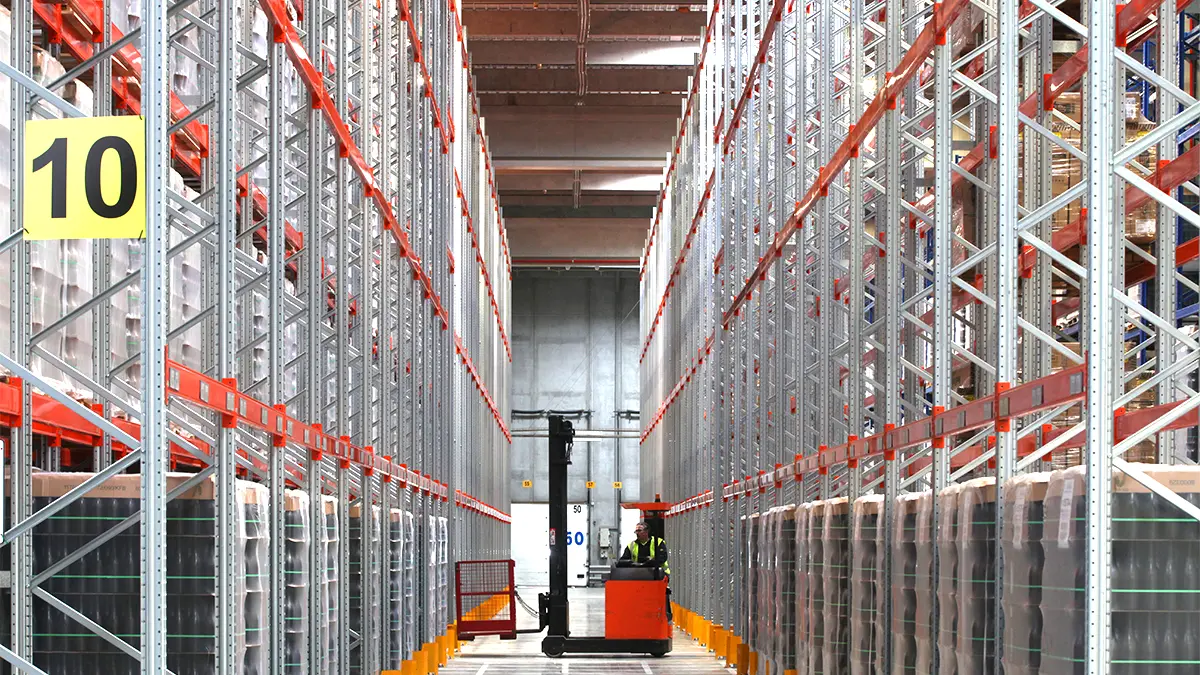In an increasingly volatile logistics environment, characterised by demand uncertainty, operational fragmentation and pressure to reduce costs, control over goods flows is more complex than ever. Within this context, the Bullwhip Effect emerges as a phenomenon that amplifies variability in orders across different stages of the supply chain, generating operational inefficiencies, increased inventory levels and deterioration in customer service.
This article offers a technical and strategic insight into the Bullwhip Effect from a logistics engineering perspective, analysing how advanced warehousing management, forecasting systems and digitalisation can play a key role in mitigating it. AR Racking, as a benchmark in industrial storage solutions, contributes with systems that enhance visibility, operational stability and responsiveness to demand fluctuations.
What is the Bullwhip Effect?
The Bullwhip Effect occurs when small fluctuations in end-customer demand result in much larger changes upstream in the supply chain. This distortion arises from reactive decisions, lack of synchronisation among supply chain participants and forecasting models misaligned with actual demand.
For instance, a slight variation in orders at a retail store may lead its distribution centre to overstock for fear of running out of stock. This same pattern is repeated by manufacturers and raw material suppliers, multiplying the initial impact.
Factors such as lack of demand visibility, inaccurate forecasts, batch ordering and lack of system integration cause the supply chain to behave in an uncoordinated manner, resulting in:
- Excessive inventory levels.
- Overstocked warehousing and transport capacity.
- Low product turnover.
- Increased logistical and financial costs.
- Risk of obsolescence.
Direct consequences in planning, inventory and transport
From a logistics engineering perspective, the Bullwhip Effect has critical implications across multiple operational areas:
Demand planning becomes unstable, requiring high safety margins that compromise efficiency. Inventory, in both volume and location, becomes misaligned with real demand, hindering stock management and generating hidden costs through unnecessary storage or unexpected stockouts.
In transport, activity peaks overload installed capacity, causing additional costs due to urgent outsourcing or inefficient resource use.
The impact also extends to workforce productivity, which is affected by abrupt workload changes. This hinders proper planning with tools like the Labour Management System (LMS), as irregular flows impair efficient task and shift allocation.

The role of industrial storage in demand variability
The warehouse, as a critical supply chain node, plays a fundamental role in absorbing variability. A poorly dimensioned, inflexible or non-adaptable storage system can worsen Bullwhip effects, becoming an operational bottleneck.
Conversely, an optimised infrastructure designed to withstand high variability environments can act as a logistics buffer, helping manage demand peaks more resiliently, improving service quality and reducing operational losses.
Key principles for storage configuration to counter the Bullwhip Effect include:
- Structural flexibility to adapt to volume variations.
- Fast access to critical references.
- Seamless integration with forecasting and inventory systems.
- Layouts that enhance flow and reduce response times.
AR Racking systems as technical support for operational stability
Storage solutions developed by AR Racking provide robustness and flexibility to tackle supply chain disruptions. Its system catalogue allows warehouse configuration to be adapted to the specific characteristics of demand, product type and turnover levels.
The following are the most effective systems to mitigate the Bullwhip Effect:
- Adjustable Pallet Racking: Provides direct access to every SKU, ideal for high order variability and product turnover.
- Live Storage Pallet Racking (FIFO): Ensures efficient stock management by entry/exit order, essential for expiry-sensitive or cyclical-demand products.
- Drive in Drive Through Racking: Maximises storage density, particularly useful during pre-peak seasonal accumulation.
- Warehouse with stacker cranes for pallets: Enables smart, autonomous and traceable product handling, minimising errors and response times.
- Mobile Pallet Racking: Optimises space without sacrificing access to multiple SKUs, offering versatility amid demand shifts.
Each system can be integrated with advanced forecasting and logistics management technologies, reinforcing supply chain control.
Integration with WMS, LMS and advanced forecasting systems
To effectively mitigate the Bullwhip Effect, warehouse system design must be integrated with technological platforms that bring operational intelligence. Notably:
- WMS (Warehouse Management System): Enables real-time inventory tracking, location and movement, aligning warehouse operations with real demand.
- LMS (Labour Management System): Optimises workforce productivity by aligning workload with fluctuations, minimising inefficiencies caused by variability.
- Forecasting and planning systems: Incorporating demand sensing and collaborative forecasting models enhances synchronisation across the chain.
The convergence of these technologies transforms the warehouse into an intelligent node capable of cushioning demand distortions without compromising efficiency.

Recommendations to minimise the Bullwhip: technical best practices
From an applied logistics engineering standpoint, these are some of the most effective measures to reduce the Bullwhip Effect:
- Establish direct, collaborative communication with all supply chain participants.
- Invest in visibility: real-time traceability of inventory and orders.
- Adopt inventory policies aligned with actual demand using continuous replenishment systems.
- Leverage historical data and AI tools to improve demand forecasting.
- Avoid overreaction to isolated variations; prioritise data-driven decisions.
- Design warehouses with scalable, versatile systems.
These practices, when combined with intelligent storage solutions and operational control technologies, drastically reduce noise amplification in the chain.
Current challenges and new capabilities of the intelligent supply chain
Today’s global disruption landscape requires a supply chain that is not only efficient, but also resilient, sustainable and adaptable. Automation, artificial intelligence and interconnectivity are redefining how products are planned, stored and distributed.
Sustainability has also taken centre stage. Implementing green strategies—such as space optimisation, logistics emissions reduction and recyclable warehouse materials—adds operational and reputational value.
The goal is no longer just to reduce the Bullwhip, but to build an intelligent supply chain based on anticipation, collaboration and informed decision-making.
Conclusion
The Bullwhip Effect represents a structural challenge that undermines the efficiency, stability and profitability of industrial supply chains. However, through a comprehensive logistics engineering approach—based on data, predictive technologies and adaptable storage systems—its impact can be significantly reduced.
AR Racking delivers solutions that not only enable smarter inventory management, but also equip the supply chain with greater adaptability to uncertainty.
Contact our specialised technical team to design an optimised storage system capable of absorbing demand fluctuations, improving operational efficiency and strengthening your logistics chain’s resilience. At AR Racking, we guide you towards a more stable, predictable and competitive supply chain.




